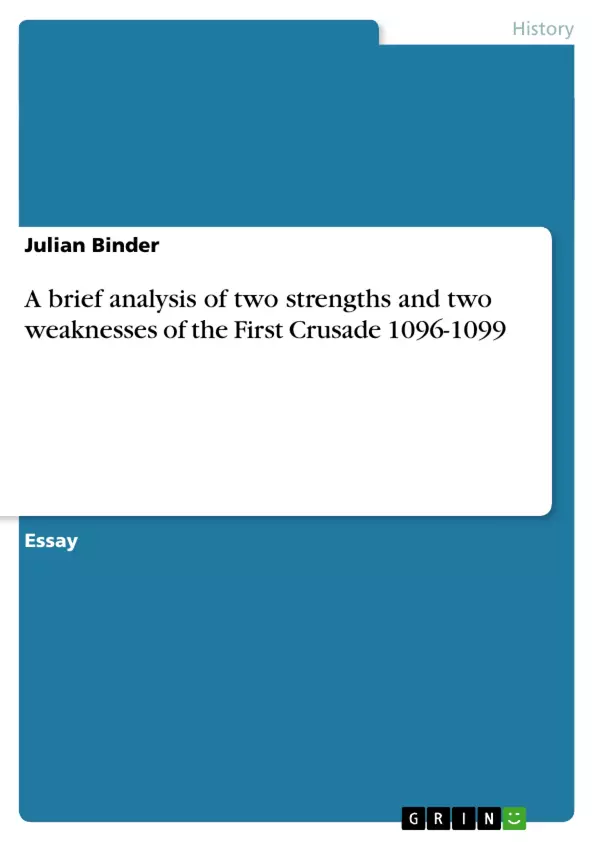The First Crusade from 1096 to 1099 A.D. was a military expedition initiated by Pope Urban II. with the goal to reconquer the Holy Sepulchre and Jerusalem, the holy city, for Christianity. Despite enormous threats, dangers and logistic problems, the Christian army
finally succeeded. The aim of this paper is to analyse and to critically discuss the strengths which enabled the crusaders to succeed in the troublesome recapture of Jerusalem, and the
weaknesses of this expedition, which nearly led to the failure of the holy mission...
Inhaltsverzeichnis (Table of Contents)
- Strengths of the First Crusade
- Faith
- Weakness of the Enemy
- Disunity of Islam
- Weaknesses of the First Crusade
- Ignorance of the Enemy and the Climate
- Logistic Problems
- Disunity among the Crusaders
Zielsetzung und Themenschwerpunkte (Objectives and Key Themes)
This essay analyzes the strengths and weaknesses of the First Crusade (1096-1099 AD), focusing on how these factors contributed to its success in capturing Jerusalem. It examines the motivations and actions of the crusaders, as well as the challenges they faced from both external and internal forces.
- The role of faith in motivating and strengthening the crusaders
- The weaknesses of the Muslim forces and their impact on the crusader campaign
- The disunity among the Muslim sects and its impact on the crusaders' strategy
- The challenges posed by logistical problems, ignorance of the terrain, and internal conflicts within the crusader army
- The influence of different primary sources on the analysis of the crusade's successes and failures
Zusammenfassung der Kapitel (Chapter Summaries)
The essay begins by exploring the strength of the crusaders' faith as a driving force behind their success. It examines how their belief in God's will, as well as their conviction in the importance of liberating Jerusalem, contributed to their determination and resilience in the face of hardship and danger.
The essay then analyzes the weaknesses of the Muslim forces, arguing that their underestimation of the crusaders and their own internal divisions played a significant role in the Christian victory. The essay highlights specific examples of Muslim tactical blunders and the discord among different Muslim sects, which allowed the crusaders to exploit their vulnerabilities.
The essay concludes by examining the weaknesses that nearly led to the failure of the First Crusade. It analyzes the crusaders' lack of knowledge about their enemies and the unfamiliar territory they were traversing, as well as their logistical challenges and internal disputes. The essay explores how these factors could have hindered their success if not for their unwavering faith and the strategic mistakes of their enemies.
Schlüsselwörter (Keywords)
The primary keywords and focus topics of this essay include: First Crusade, Holy Sepulchre, Jerusalem, faith, crusaders, Muslim forces, weakness, strength, logistic problems, disunity, internal conflicts, primary sources, Gesta Francorum, Fulcher of Chartres.
- Quote paper
- Julian Binder (Author), 2012, A brief analysis of two strengths and two weaknesses of the First Crusade 1096-1099, Munich, GRIN Verlag, https://www.grin.com/document/189684



